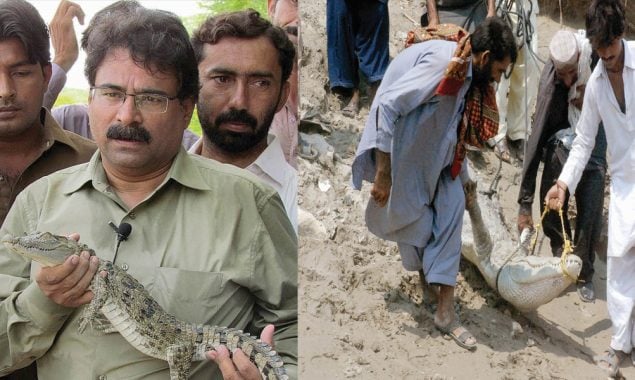Synopsis
One of the seven canals branching out from the Indus River at Sukkur contains freshwater crocodiles

The Nara Canal – one of the seven canals branching out from the Indus River at the colonial era Sukkur Barrage – is a 364-kilometer-long waterway, having the distinction of being the rare habitat of the large semi aquatic reptile called the crocodile.
The crocodiles found in the Nara Canal are mugger or marsh crocodiles – medium-sized broad-snouted crocodiles –native to freshwater habitats from southern Iran to the Indian subcontinent.
The canal, which runs from the Sukkur Barrage to Sindh province’s Sanghar and Mirpur districts, once also had gharial or fish-eating crocodiles with a long snout. Gharial was last seen in the Nara Canal in 1974 but it later disappeared.
According to an estimate, there are more than 200 marsh crocodiles in the Nara Canal at present. Most of the animals are in Salehpat Tehsil of Sukkur. The Nara Canal irrigates millions of acres of agricultural land and people living along its banks have occasionally been attacked by these animals.
At the Nara Canal’s RD-115 area, a crocodile grabbed a four-year-old girl, Sadia Mahar, who was bathing by the canal a few months back, and dragged her into the water. This girl could not be traced.
There have also been reports of the crocodiles praying on cattle of local peoples in areas where the human population has increased near the banks of the canal.
Sometimes these crocodiles, especially the female crocodiles, come out of the canal in search of food and go out into the fields with their babies. At times, these animals get stuck in small pools surrounding the canal. When this happens the local people rescue these animals and return them to the Nara Canal.
Cotton, wheat, sugarcane and crops of various vegetables are grown on the agricultural lands on the banks of the Nara Canal. Large-scale farming involves movement of people and their livestock.
When big crocodiles come out in the fields and eat some cattle, the locals sometimes get angry and tie the predator with ropes. In such cases, the wildlife department intervenes and the crocodiles are rescued and released back into the canal.
One year back, a crocodile ate another girl in the Salehpat area. It was a great tragedy and the people were furious but despite that anger, the locals did not attack the wild animals.
In fact, the people know that the crocodiles of the Nara Canal are not to blame. These crocodiles have never invaded human populations, but humans have moved closer to their natural habitat, which has led to this situation. The crocodiles of the Nara Canal are the beauty and identity of this canal.
Mir Akhtar Talpur, an official of the Wildlife Department in Sukkur, is conducting research on various aquatic creatures, including the Indus Blind Dolphin.
To a question as to why the crocodiles are found in the Nara Canal and not in the River Indus or any other canal flowing out of the river, Talpur said the crocodiles have never been found in any other canal or the River Indus because the Nara Canal provides them the most suitable habitat.
“There are sandy areas and bushes along this canal where crocodiles lay their eggs. Secondly, this canal passes through a very large desert area where human population is less.
“Their numbers have increased. These crocodiles have not been killed or hunted, while the Nara Canal is a canal more than 364 km long, with no shortage of food,” he said.
He said the crocodiles of the Nara Canal, however, run short of food when the canal is closed from the Sukkur Barrage for 15 days a year for annual cleaning.
“During this time the water level in the canal decreases and the crocodiles move to the nearby populations from where they catch chickens and goats and disturb the locals.”
He said crocodiles have never invaded human populations or fields. They have attacked only a couple of children while they were bathing in the canal or playing by it. Talpur said the crocodiles of the Nara Canal are living in their natural environment and therefore their numbers are increasing.
“Occasional crocodile attacks on humans are due to the proximity of the human population to the Nara Canal, otherwise crocodiles prefer to stay away from the human population,” he added.
Read More News On
Catch all the Breaking News Event and Latest News Updates on The BOL News
Download The BOL News App to get the Daily News Update & Follow us on Google News.




